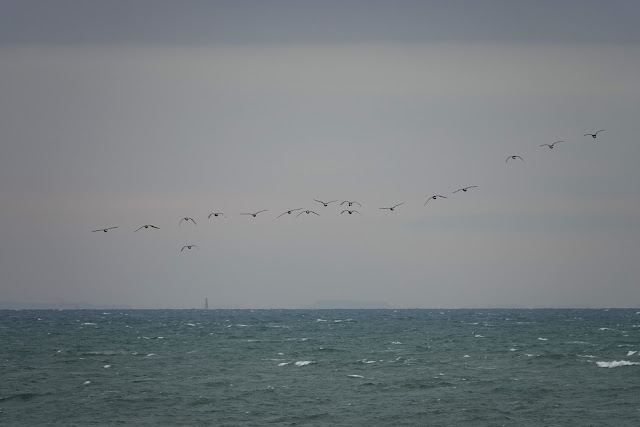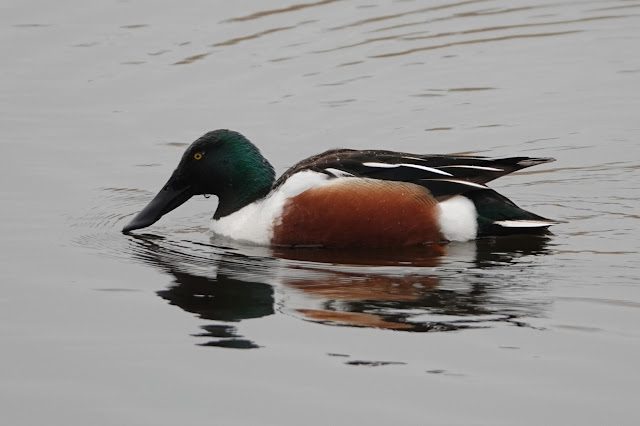A www.blueeyedbirder.com day out:
A few spots was what the weather forecast suggested for out
day out in Kent with a light southerly wind. Perfect I thought for a wander
around Dungeness at the end of March. We
met at 8am in the ARC as the first few drops of rain started to fall. It was quite cool and the breeze hardly felt
southerly in temperature. The water
level had gone up once again and there were literally just a handful of Tufted
Duck and Pochard to be seen bobbing out front along with plumed Great Crested
Grebe and two male and a female Goldeneye.
 |
| Goldeneye |
A single Oystercatcher was hanging onto the only emerged
nubbin of land. A 2nd year male
Marsh Harrier was out hunting and was still sporting vivid cream shoulder pads
that glowed in the low light while the bushes held a few singing Chiffchaffs
and Tits.
 |
| One of the dwarf Salix species but I have no idea what one |
With the weather holding on just about, we made our way down
to the Lighthouse where the wind had got up in the spaces of just a few minutes
and was fiercely blowing into our faces. Not quite what we expected. We lurked outside the hide trying to find
some shelter and actually had a quite a good session with 32 Common Scoter with
a single male Velvet, 47 Brent Geese, a Razorbill and a female Merganser east
while Gannets milled around offshore and a single distant Sandwich Tern was
seen. Great crested Grebes bobbed
around and drifted along with the tide while Common Gulls were seen amongst the
Herring and hulking Great Black-backs. The
French coast was visible for miles to the east with trees, radio masts, pylons
and buildings being visible. It was
quite remarkable.
 |
| Great Black-backed Gull |
 |
| Brent Geese with France beyond |
No Black Redstarts were visible or audible in the complex
behind and the walk from there down to the Obs Moat produced no small birds bar
a couple of displaying Meadow Pipits and four smart Pied Wagtails. Where were the Wheatears?!
Two Peregrines came into the pylons to shelter from the rain
and I was sure that both were males. They
chose different pylons some way apart and surely the females should be sitting
tight at the moment?
 |
| Peregrine |
 |
| Purple nubbins of new Sea Cabbage shoots |
At the Moat our luck changed with a flurry of Firecrest activity.
Four birds were quickly seen either side of the path and performed admirably
flashing their almost emerald upperparts and gleaming heads. There were smiles all round. Three more were found further round but
despite scanning we were still in a Wheatear free zone. Two Skylarks, two Chiffchaffs and four Meadow
Pipits were added but nothing else before we got back to the Lighthouse garden where
the Euphorbias were glowing lime green but only two more Chiffchaffs could be
found.
 |
| Rabbit Gorse topiary |
 |
| Euphorbias |
We slow drove back out scanning for errant white arses and shivering tails but to no avail and so headed for Boulderwall and Cooks Pool which looked great but lacked the all important Ibises. Some splendid Curlew probed the grass and a small flock of Wigeon were seen grazing and a Great White Egret was playing hide an seek. A Raven followed the car as we drove down further and after a recuperative cuppa we headed round to Springfield Bridge where the rain was now heavy and icy.
None of us had any inclination to get out and
stare at Dengemarsh that was devoid of any birds at all so I opted to drive
east to Sandgate to try for the Hume’s Yellow-browed Warbler in Enbrook
Park. The trees offered us some shelter
in this lovely ravine park but we could not find the little warbler but were
content with more excellent views of several Firecrests and Long-tailed Tits
and I saw a pair of Grey Wagtails at the waterfall on my second circuit during
lunch.
 |
| Blackbird - sometimes the 'common' can become an eye-catching beauty. When did you last really look at one closely? |
 |
| Grey Wagtail |
 |
| It would have been remiss of me not to note the Ectoedemia heringella on the nearly every Holm Oak leaf |
Northwards now to Stodmarsh where at least I hoped we should see some more birds! Just as we reached the village I picked up five Cattle Egrets with some cows in a roadside field and thankfully we could watch them without getting out in the rain!
 |
| Cattle Egrets |
Once there
the rain abated somewhat and we actually had a fairly pleasant couple of hours
walking to the first two hides and back.
Chiffchaffs, Blackcaps and Chaffinches sang as we approached the Reedbed
Hide and Bullfinches called softly but out of sight. The water levels were high here too with just
a few Shoveler, Mute Swans, Coots and Moorhens out front while a pair of Great
Crested Grebes were nest building and Bearded Tits could be heard pinging from
both sides and occasionally seen dashing over the reed top with tails bobbling.
 |
| Shoveler - so delicate with such a big bill |
 |
| Shoveler |
The male Bullfinch was actually singing as we walked back
out but remained hidden and Water Rails squealed and kipped from all around us
while a Raven kronked but never came into view.
The Marsh Harriers were putting on a superb display and at least three
full adult males were patrolling and interacting in some good aerial tussles
with the females.
Evidence of Beavers were everywhere with some classic spear
point stumps, half felled trees and seriously gnawed tree trunks. I must get back and see them one evening.
The sweet scent of the Cherry Plums reached us now that the
rain had stopped but it was still very cool and there were no insects of any
sort to be seen. A few Tufted Ducks were out on the main lake and thankfully
the female Ring-necked Duck was quickly found.
She was actively feeding but showed very well in the scope. Given how many times I have not see RND this
year it was actually something of a relief to clap eyes on one!
 |
| Cherry Plum |
 |
| Ring-necked Duck |
Squadrons of Cormorants kept arriving from the coast and
heading off to Westbere and Cetti’s Warblers shouted at us with great
regularity from the path side bushes but we did not even get a single glimpse
despite their proximity. Song Thrushes
had started singing as the rain stopped and one stayed put for us all to watch
as he serenaded in the late afternoon.
We took the boardwalk loop on the way back and the Beaver
work was even more evident with a dam and new pools and so many cleared
saplings. The clouds were building again
so we made our way back to the cars stopping to have a look at the first Cuckoo
Flower of the season by the last pool.
 |
| Cuckoo Flower - very bushy plants |
It had been a difficult day but by the end we had actually
done quite well given the atrocious conditions.
The journey home was enlivened by seven Med Gulls in a field alongside
the M2 as is now the norm for this time of year!














Euphorbia characias, Mediterranean Spurge for the Euphorbia-pretty good at self-seeding outside gardens.
ReplyDeleteThank you
Delete